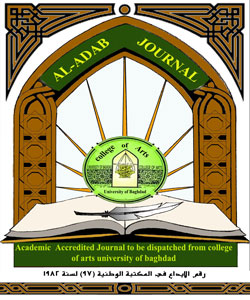الحيوية الذاتية لدى طلبة السادس الاعدادي
DOI:
https://doi.org/10.31973/aj.v2i138.1743الكلمات المفتاحية:
الحيوية الذاتية، طلبة السادسالملخص
يمكن وصف الحيوية الذاتية بنحو عام بأنها شعور فردي للطاقة الداخلية التي تدفع الفرد نحو الحياة بهمة ونشاط، والتي تتأثر بالعوامل الفسيولوجية والنفسية، ولما كان طلبة السادس الإعدادي يعيشون واقعاً مليئاً بالتغيرات المستجدة يوماً بعد يوم، فهم يتعرضون إلى ضغوطات نفسية، تخيّم بظلالها على واقعهم الدراسي، لذا اختار الباحث أن تكون عينة دراسته طلبة السادس الإعدادي ، هدفت الدراسة التعرف إلى مدى امتلاكهم للحيوية الذاتية في العملية التعليمية، والفروق ذات الدلالة الإحصائية في الحيوية الذاتية لهم تبعاً لمتغير الجنس(ذكور-أناث) والتخصص(العلمي –الأدبي) ، وقام الـباحث ببناء مقياس الـحيـويـة الـــذاتيـة معتمداً على نظرية ريان فريدريك (Ryan, & Frederick, 1997)، ليتلاءم مع أهداف البحث وعينته، وقد كانت فقرات مقياس الحيوية الذاتية بصورتها النهائية (40) فقرة موزعة بين أربعة مجالات، وجرى استخراج الصدق والثبات، واستخراج القوة التمييزية بطريقتي أسلوب المجموعتين المتطرفة، وعلاقة الفقرة بالدرجة الكلية، وللتحقق من أهداف البحث جرى اختيار (468) طالباً وطالبة من طلبة السادس الإعدادي في محافظة بغداد ، وبعد تطبيق البيانات ومعالجتها أظهرت النتائج ما يأتي :
1- لدى طلبة السادس الإعدادي (ذكور- إناث) حيوية ذاتية.
2- لا توجد فروق ذات دلالة إحصائية بالحيوية الذاتية لدى طلبة السادس الإعدادي، بحسب متغير الجنس، والتخصص، والتفاعل بين الجنس والتخصص.
وفي ضوء نتائج البحث يضع الباحث جملة من التوصيات والمقترحات، ومنها:
- على وزارة التعليم العالي والبحث العلمي وضع الخطط فيما يخص تخفيض معدلات القبول العالية من خلال توسعة القبولات، وبالنتيجة، يكون قبول الطلبة في الكليات التي يرغبون فيها متاحاً، فضلاً عن عدم لجوئهم إلى الكليات الأهلية.
التنزيلات
المراجع
AKIN, A., & AKIN, U. (2015). DO SCHOOL EXPERIENCES PREDICT SUBJECTIVE VITALITY IN TURKISH COLLEGE STUDENTS?. Education Sciences & Psychology, 34(2).
Al-Kubaisi, Waheeb Majeed and Al-Janabi, Younis Saleh (1987): Samples and their use in psychological educational research, Journal of Generations Studies, Issue. (2).
Al-Kubaisi, Waheeb Majeed and Al-Janabi, Younis Salih (1987): Samples and Areas of Use in Psychoeducational Research, Journal of Generational Studies, Issue (2).
Allen, M. J., & Yen, W. M. (1979). Introduction to measurement theory. Monterey, CA: Brooks.
Allen, T. D., & Kiburz, K. M. (2012). Trait mindfulness and work–family balance among working parents: The mediating effects of vitality and sleep quality. Journal of Vocational Behavior, 80(2), 372–379.
Al-Mashhadani, Mahmoud Hassan and Hormuz, Amir Hanna (1989): Statistics, House of Wisdom, University of Baghdad, Iraq.
Al-Mashhadani, Mahmoud Hassan and Hormuz, Amir Hanna (1989): Statistics, House of Wisdom, University of Baghdad, Iraq.
Anastasi, A. (1976): Psychology Testing, New York, McMillon on publishing.
Anastasi, A., & Urbin, Susana (1997): Psychological testing, New Jersey, Prentice Hall.
Bostic, T. J., Rubio, D. M., & Hood, M. (2000). A validation of the subjective vitality scale using structural equation modeling. Social Indicators Research, 52(3), 313-324.
Deci, E. L., & Ryan, R. M. (2008). Self-determination theory: A macrotheory of human motivation, development, and health. Canadian Psychology/Psychologie canadienne, 49(3), 182–185. https://doi.org/10.1037/a0012801
Deci, E., & Ryan, R. (2000). The “What” and “Why” of goal pursuits: Human needs and the self-determination of behavior. Psychological Inquiry, 11(4), 227–268.
Ebel, R.L. (1972). Essential of Educational measurement, 2nd, New Jersey, Prentice- Hill, Inc, Englewood cliffs.
Farag, Safwat (1980): Psychometrics, First Edition, Arab Thought House, Cairo.
Faraj, Safwat (1980): Psychometrics, first edition, Arab Thought House, Cairo.
Fini, A. A. S., Kavousian, J., Beigy, A., & Emami, M. (2010). Subjective vitality and its anticipating variables on students. Procedia-Social and Behavioral Sciences, 5, 150-156.
Kark, R., & Carmeli, A. (2009). Alive and creating: The mediating role of vitality and aliveness in the relationship between psychological safety and creative work involvement. Journal of Organizational Behavior: The International Journal of Industrial, Occupational and Organizational Psychology and Behavior, 30(6), 785-804.
Khalkhali, V., Sharifi, R., Beigi, S. M., & Khalkhali, F. (2012). What can students' perceived locus of causality tell us about their subjective vitality?. Education Sciences & Psychology, 21(2).
Kubzansky, L. D., & Thurston, R. C. (2007). Emotional vitality and incident coronary heart disease: benefits of healthy psychological functioning. Archives of General Psychiatry, 64(12), 1393-1401.
Lavrusheva, Olga. (2020). The concept of vitality. Review of the vitality-related research domain. New Ideas in Psychology, 56, 100752.
Maslach, C.,1, Schaufeli, W.B., & Michael P. Leiter, M.P. (2001). Job Burnout. Annual Review of Psychology, 52: pp:397-422.
Masoud, Gebran, (2019). Al-Raed: a modern lexicon whose vocabulary is arranged according to its first letters / Gibran Masoud.
Masoud, Gibran (2019). Al-Raed: A modern linguistic dictionary arranged according to its initials / Gibran Masoud.
McNair, D. M., Lorr, M., & Droppleman, L. (1971). Profile of Mood States manual. San Diego, CA: Educational and Industrial Testing Service.
Melhem, Sami Mahmoud (2009): Measurement and Evaluation in Education and Psychology, 4th Edition, Dar Al-Masirah for Publishing and Distribution, Amman.
Melhem, Sami Muhammad (2000). Research Methods in Education and Psychology, Dar Al Masirah for Publishing and Distribution, Amman, Jordan.
Melhem, Sami Muhammad (2000). Research Methods in Education and Psychology, Dar Al-Masirah for Publishing and Distribution, Amman, Jordan.
Mouratidis, A. A., Vansteenkiste, M., Sideridis, G., & Lens, W. (2011). Vitality and interest–enjoyment as a function of class-to-class variation in need-supportive teaching and pupils' autonomous motivation. Journal of Educational Psychology, 103(2), 353.
Novianti, N. (2002). ʺSpeech Acts of Apologizing by Indonesians Learning English as A Foreign Language: A Case Study in The Department of English Education, Indonesia University of Education.ʺ Unpublished Undergraduate Thesis, Department of English Education, UPI.
Osama Kamel Rateb (2000). Sports Psychology: Concepts - Applications. Edition 2: Cairo House of Arab Thought.
Osama Kamel salary (2000). Sports Psychology: Concepts - Applications. I: Cairo is the house of Arab thought.
Özkara, A. B., Kalkavan, A., Alemdağ, S., Alemdağ, C., & Çavdar, S. (2017). The role of physical activity in pre-service teachers’ subjective vitality. Physical education of students, 21(3), 134-139.
Penninx, B., Guralnik, J. M., Bandeen-Roche, K., Kasper, J. D., Simonsick, E. M., Ferrucci, L., et al. (2000). The protective effect of emotional vitality on adverse health outcomes in disabled older women. Journal of the American Geriatrics Society, 48(11), 1359–1366.
Ryan, R. M., & Frederick, C. (1997). On energy, personality, and health: Subjective vitality as a dynamic reflection of well‐being. Journal of personality, 65(3), 529-565.
Ryan, R. M., and Deci, E. L. (2000). "Self-Determination Theory and the Facilitation of Intrinsic Motivation, Social Development, and Well-being," American Psychologist (55:1), pp. 68-78.
Ryan, R., Rigby, C., & Przybylski, A. (2006). The motivational pull of video games: A self-determination theory approach. Motivation and Emotion, 30, 347–363.
Sarıçam, H. (2015). Mediating role of self-efficacy on the relationship between subjective vitality and school burnout in Turkish adolescents. International Journal of Educational Researchers, 6(1), 1-12.
Seligman, M. E., & Csikszentmihalyi, M. (2000). Positive psychology: An introduction. American Psychologist, 55, 5-14.
Sheldon, K. M., & Krieger, L. S. (2007). Understanding the negative effects of legal education on law students: A longitudinal test of self-determination theory. Personality and
Shogren, K. A., Wehmeyer, M. L., Palmer, S. B., Soukup, J. H., Little, T., Garner, N. ... Lawrence, M. (2008). Understanding the construct of self-determination: Examining the relationship between The Arc's Self-Determination Scale and the American Institute for Research Self-Determination Scale. Assessment for Effective Instruction, 33, 94–107.Social Psychology Bulletin, 33(6), 883-897.
Thayer, R. E. (1978). Toward a psychological theory of multidimensional activation (arousal). Motivation and Emotion, 2, 1-34.
Thayer, R. E. (1987). Energy, tiredness and tension effects of a sugar snack versus moderate exercise. Journal of Personality and Social Psychology, 52(1), 119-125.
Thayer, R. E. (1996). The origin of everyday moods. New York: Oxford University.
Thieler, I. (2017). Basic psychological needs: determinants or correlates of subjective vitality and fatigue?: A systematic review of the literature (Master's thesis, University of Twente).
Thomlison B. (2001). Descriptive studies. In Thyer B. (Ed.), The handbook of social work research methods (pp. 131–141). Thousand Oaks, CA: Sage.
Thorndike, Robert and Hagen, Elizabeth (1989): Measurement and Evaluation in Psychology and Education, translated by: Abdullah Al-Kilani and Abdel-Rahman Adas, Arab Book Center.
Thorndike, Robert and Heagan, Elizabeth (1989): Measurement and Evaluation in Psychology and Education, translated by: Abdullah Al-Kilani and Abdul-Rahman Adas, The Arab Book Center.
Vanden Bos, G. R. (2013). APA dictionary of clinical psychology. American Psychological Association.
Vlachopoulos, S. P. (2012). The role of self-determination theory variables in predicting middle school students’ subjective vitality in physical education. Hellenic Journal of Psychology, 9(2), 179-204.
التنزيلات
منشور
إصدار
القسم
الرخصة
:حقوق الطبع والنشر والترخيص
بالنسبة لجميع البحوث المنشورة في مجلة الآداب، يحتفظ الباحثون بحقوق النشر. يتم ترخيص البحوث بموجب ترخيص Creative Commons CC BY 4.0 المفتوح ، مما يعني أنه يجوز لأي شخص تنزيل البحث وقراءته مجانًا. بالإضافة إلى ذلك ، يجوز إعادة استخدام البحث واقتباسه شريطة أن يتم الاستشهاد المصدر المنشور الأصلي. تتيح هذه الشروط الاستخدام الأقصى لعمل الباحث وعرضه.
:إعادة إنتاج البحوث المنشورة من الناشرين الآخرين
من الضروري للغاية أن يحصل الباحثون على إذن لإعادة إنتاج أي بحث منشورة (أشكال أو مخططات أو جداول أو أي مقتطفات من نص) لا يدخل في نطاق الملكية العامة أو لا يملكون حقوق نشرها. يجب أن يطلب الباحثون إذنًا من مؤلف حقوق النشر (عادة ما يكون الناشر).
يطلب الإذن في الحالات التالية:
بحوثك الخاصة المنشورة من قِبل ناشرين آخرين ولم تحتفظ بحقوق النشر الخاصة بها.
مقتطفات كبيرة من بحوث أي شخص أو سلسلة من البحوث المنشورة.
استخدم الجداول والرسوم البيانية والمخططات والمخططات والأعمال الفنية إذا لم يتم التعديل عليها.
الصور الفوتوغرافية التي لا تملك حقوق لنشرها.
لا يطلب الإذن في الحالات التالية:
إعادة بناء الجدول الخاص بك مع البيانات المنشورة بالفعل في مكان آخر. يرجى ملاحظة أنه في هذه الحالة يجب عليك ذكر مصدر البيانات في شكل "بيانات من ..." أو "مقتبس من ...".
تعتبر عروض الأسعار القصيرة معقولة الاستخدام العادل ، وبالتالي لا تتطلب إذنًا.
الرسوم البيانية ، الرسوم البيانية ، المخططات ، الأعمال الفنية التي أعاد الباحث رسمها بالكامل والتي تم تغييرها بشكل ملحوظ إلى درجة لا تتطلب الاعتراف.
الحصول على إذن
لتجنب التأخير غير الضروري في عملية النشر ، يجب أن تبدأ في الحصول على أذونات في أقرب وقت ممكن. لا يمكن لمجلة الآداب نشر بحث مقتبس من منشورات أخرى دون إذن.
قد يمنحك مالك حقوق الطبع والنشر تعليمات بشأن شكل الإقرار الواجب اتباعه لتوثيق عمله ؛ بخلاف ذلك ، اتبع النمط: "مستنسخ بإذن من [المؤلف] ، [كتاب / المجلة] ؛ نشره [الناشر] ، [السنة]." في نهاية شرح الجدول ، الشكل أو المخطط.

























